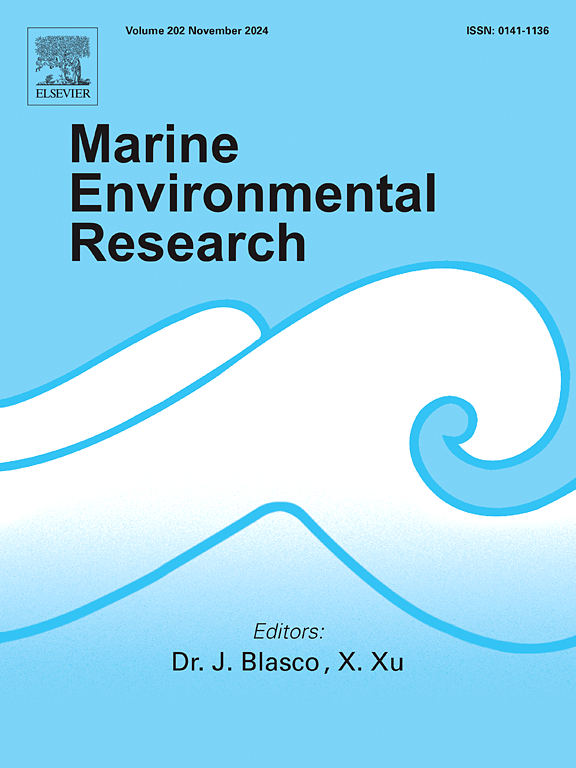How global container shipping emissions and marine primary production are related to: A geographically and temporally weighted analysis
IF 3
3区 环境科学与生态学
Q2 ENVIRONMENTAL SCIENCES
引用次数: 0
Abstract
Ocean sustainability is a critical global issue. However, increasing CO2 emissions from container shipping have adversely impacted marine ecosystems. Oceanic net primary production (NPP) is a key indicator of marine ecosystem health. Despite abundant research showing a relationship between CO2 and NPP, limited attention has been given to the relationship between CO2 emissions from ships and NPP. This study estimates global CO2 emissions from container shipping from 2018 to 2021 using the Ship Traffic Emission Assessment Model (STEAM), then combines remote sensing NPP data and applies a geographically and temporally weighted regression (GTWR) model to explore their spatiotemporal relationship. The results reveal the temporal variation patterns, hotspot regions, and clustering characteristics of CO2 emissions from container shipping and NPP. Furthermore, the findings indicate that NPP's response to CO2 emissions shows varying correlations. In western South America, southwestern Africa, the equatorial Atlantic, and the southern Greenland Sea, CO2 emissions from container shipping promote NPP, while in the Indian Ocean, Black Sea, Mediterranean Sea, and North Atlantic, CO2 emissions inhibit NPP. That implies differing environmental sensitivities and the variations in balance between the positive effects of increased dissolved inorganic carbon (DIC) and the negative effects of ocean acidification. This study clarifies the spatiotemporal heterogeneous relationship between CO2 emissions from container shipping and NPP, providing strong support for the development of sustainable oceans.

全球集装箱运输排放与海洋初级生产之间的关系:地理和时间加权分析
海洋的可持续性是一个关键的全球性问题。然而,集装箱运输产生的二氧化碳排放量的增加对海洋生态系统产生了不利影响。海洋净初级生产力(NPP)是衡量海洋生态系统健康状况的重要指标。尽管大量研究表明CO2与NPP之间存在关系,但对船舶CO2排放与NPP之间的关系关注有限。本研究利用船舶交通排放评估模型(STEAM)估算了2018 - 2021年全球集装箱航运的二氧化碳排放量,并结合遥感NPP数据,采用地理和时间加权回归(GTWR)模型探讨了它们之间的时空关系。结果揭示了集装箱航运和NPP二氧化碳排放的时空变化特征、热点区域和聚类特征。此外,研究结果表明,NPP对CO2排放的响应表现出不同的相关性。在南美洲西部、非洲西南部、赤道大西洋和格陵兰海南部,集装箱航运CO2排放促进了NPP,而在印度洋、黑海、地中海和北大西洋,CO2排放抑制了NPP。这意味着不同的环境敏感性以及增加溶解无机碳(DIC)的积极影响与海洋酸化的消极影响之间平衡的变化。本研究阐明了集装箱航运CO2排放与NPP的时空异质性关系,为海洋可持续发展提供有力支持。
本文章由计算机程序翻译,如有差异,请以英文原文为准。
求助全文
约1分钟内获得全文
求助全文
来源期刊

Marine environmental research
环境科学-毒理学
CiteScore
5.90
自引率
3.00%
发文量
217
审稿时长
46 days
期刊介绍:
Marine Environmental Research publishes original research papers on chemical, physical, and biological interactions in the oceans and coastal waters. The journal serves as a forum for new information on biology, chemistry, and toxicology and syntheses that advance understanding of marine environmental processes.
Submission of multidisciplinary studies is encouraged. Studies that utilize experimental approaches to clarify the roles of anthropogenic and natural causes of changes in marine ecosystems are especially welcome, as are those studies that represent new developments of a theoretical or conceptual aspect of marine science. All papers published in this journal are reviewed by qualified peers prior to acceptance and publication. Examples of topics considered to be appropriate for the journal include, but are not limited to, the following:
– The extent, persistence, and consequences of change and the recovery from such change in natural marine systems
– The biochemical, physiological, and ecological consequences of contaminants to marine organisms and ecosystems
– The biogeochemistry of naturally occurring and anthropogenic substances
– Models that describe and predict the above processes
– Monitoring studies, to the extent that their results provide new information on functional processes
– Methodological papers describing improved quantitative techniques for the marine sciences.
 求助内容:
求助内容: 应助结果提醒方式:
应助结果提醒方式:


